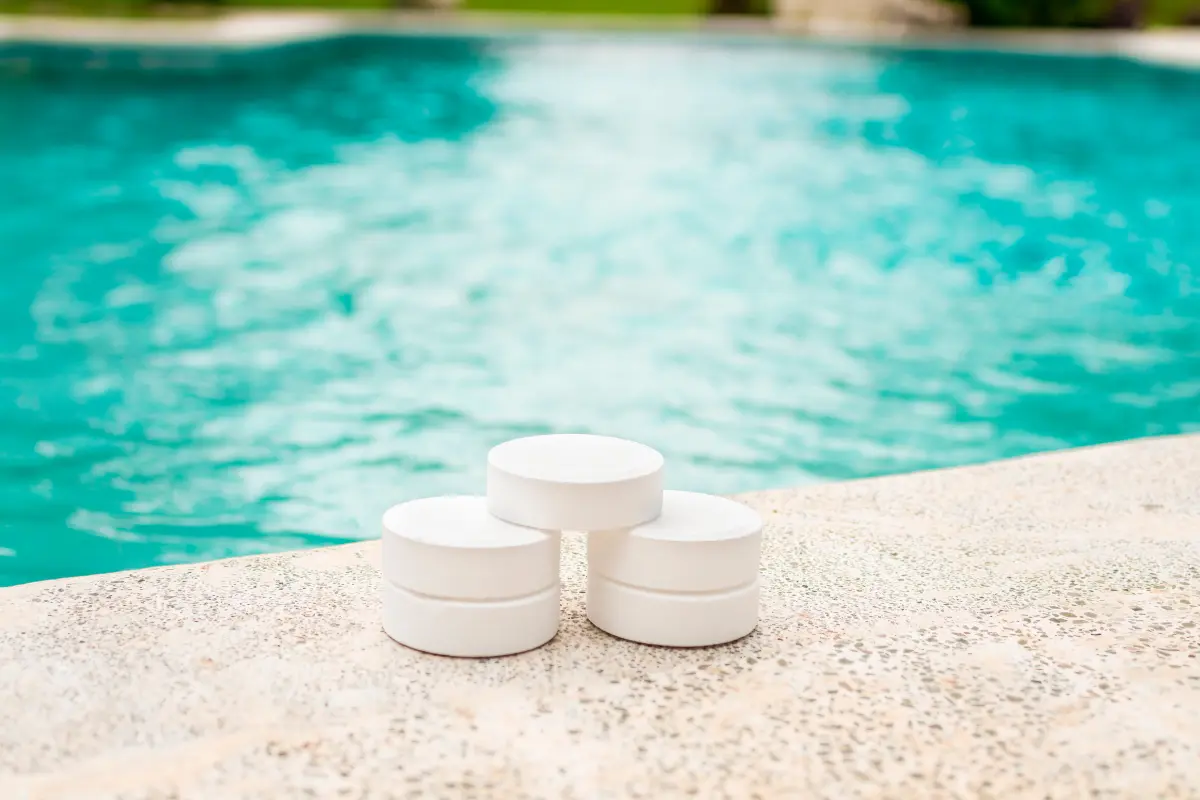
Have you ever wondered why, sometimes, despite regular cleaning, your swimming pool doesn’t quite shimmer as it should? The answer often lies in a crucial process known as ‘pool shocking’.
But what exactly is pool shock?
Simply put, it’s a powerful method of sanitising your pool, ensuring it remains a safe and enjoyable place for everyone. Adding a significant dose of chlorine or a specialised shock product can effectively neutralise harmful contaminants, from pesky algae to invisible bacteria. It enhances the clarity of your pool water and ensures it’s hygienic and safe for every plunge you take.
In the following sections, we’ll learn how to shock a pool effectively – a critical step and game-changer in pool care.
Pool Shock and Its Importance
Now that we’ve dipped our toes into what pool shock is, let’s explore why it’s such a crucial part of your pool care routine.
Imagine your pool as a bustling ecosystem. Over time, it’s not just the leaves and debris that find their way in.
Invisible guests like chloramines, bacteria, and algae also join the party, often uninvited. Shocking your pool is like sending in a specialised clean-up crew targeting these unwelcome elements.
Chloramines, for instance, result from chlorine mingling with organic matter like sweat and oils. Not only do they give off that strong ‘chlorine’ smell, but they can also irritate your skin and eyes. Shocking break these compounds down, restoring the clarity and health of your water.
But wait, there’s more.
Algae and bacteria, if left unchecked, can turn your pool into their playground. Regular shocking halts their growth in their tracks, preventing that dreaded green tinge and ensuring the water remains safe for everyone.
Regular pool shocking is your best defence against these invisible threats. It keeps the water crystal clear, hygienic, and inviting. So, while it might seem like just another task on your pool maintenance checklist, its impact is profound, ensuring your pool remains a refreshing oasis for all.
When to Shock Your Pool
Recognising the right time to shock your pool is like becoming a detective in your own backyard. The clues? They’re right there in the water.
If you notice the pool water starting to lose its crystal-clear charm, appearing a bit cloudy, or if there’s an unusual chlorine smell, these are your cues. It’s the pool’s way of whispering, “I need a shock treatment.”
As for the frequency, it’s not just about marking dates on the calendar. A good rule of thumb is to shock your pool every week or fortnight, especially during peak swimming seasons. Consistency is key to keeping those uninvited microscopic guests at bay.
But hold on, sometimes your pool demands a bit more attention.
After a bustling pool party, following a heavy rainstorm, or during periods of intense heat, your pool might need an extra dose of shock. These events can throw off the delicate balance of your pool’s ecosystem, making an additional shock treatment beneficial and necessary.
Get a Free No Obligation On-Site Consultation Now
Please fill in your details below and we’ll get back to you.
Types of Pool Shock Treatments
Choosing the right type of pool shock is similar to selecting the perfect tool for a job. Each type has its unique strengths and ideal scenarios for use. Let’s break down the options:
Calcium Hypochlorite (Cal Hypo)
It’s the heavyweight of pool shocks. Ideal for a thorough cleanse, Cal Hypo is known for its high chlorine content and effectiveness against tough algae blooms. However, it does increase the calcium level in your pool, which is something to consider if you already have high calcium hardness.
Lithium Hypochlorite
Think of this as the quick and efficient option. It dissolves rapidly, making it a go-to choice for a swift shock treatment. While effective, its higher cost and reduced availability can be a downside.
Dichlor (Dichloroisocyanuric Acid)
Dichlor is the all-rounder. It’s stabilised and lasts longer under the sun’s UV rays. It is, therefore, a great choice for outdoor pools that receive a lot of sunlight. However, it does add cyanuric acid to your pool, which can accumulate over time.
High levels of cyanuric acid can actually hinder chlorine’s effectiveness. The ideal range for cyanuric acid in a residential pool is between 30 and 50 parts per million (ppm). If your levels are too high, you may need to partially drain and refill your pool with fresh water or use specialised cyanuric acid reducers.
Non-Chlorine Shock
For those looking for a chlorine-free option, this is your pick. It’s great for regular maintenance and allows you to use the pool soon after treatment. However, it may not be as effective against stubborn algae.
Comparison Table
| Type | Chlorine Content | Dissolving Speed | Cost | Additional Effects |
|---|---|---|---|---|
| Cal Hypo | High | Slow | Moderate | Increases calcium |
| Lithium Hypochlorite | Moderate | Fast | High | - |
| Dichlor | Moderate | Moderate | Moderate | Adds cyanuric acid |
| Non-Chlorine | None | Fast | Moderate | Chlorine-free |
How to Shock a Pool Steps

- Test the Water: Before you begin, test your pool water to understand the chemical levels. Pay close attention to the chlorine and pH levels.
- Safety First: Always wear protective gear such as gloves and goggles when handling pool chemicals. Safety should be your top priority.
- Prepare the Shock Product: Depending on the type of shock product you are using (e.g., Calcium Hypochlorite, Dichlor, etc.), preparation may vary. Some products must be pre-dissolved in water, while others can be added directly to the pool.
- Turn Off the Pool Filter: Before adding the shock, turn off your pool’s filtration system to prevent the chemicals from being filtered out too quickly.
- Add the Shock to the Pool: If your product needs to be pre-dissolved, do so in a clean, plastic bucket with water from the pool. Gradually add the shock to the pool water, spreading it evenly around the edges or following the manufacturer’s instructions.
- Turn On the Pool Filter: Turn the filter back on after adding the shock. In this way, the chemicals are circulated throughout the pool.
- Wait and Re-Test: Allow the shock to work its magic for the recommended time (usually overnight). Afterwards, re-test the water to ensure the chemical levels are back to normal.
- Resume Swimming: Once the chlorine levels have returned to a safe range (typically 1-3 ppm), it’s safe to resume swimming.
Disclaimer: The exact process may vary slightly based on the type of shock product you use, so always refer to the manufacturer’s instructions.
Post-Shocking Care and Maintenance
After you’ve completed the pool shocking process, it’s important to focus on the subsequent care and maintenance.
The first step in keeping the proper balance in your pool water is to routinely check the chlorine levels to ensure they have returned to a safe range for swimming.
In addition to monitoring chlorine, consistent pool maintenance is crucial. It is necessary to thoroughly clean the filter system, skim the leaves and debris, and check the pH balance.
Regular upkeep is key to keeping your pool in excellent condition and ready for use.
Conclusion
More than just a regular maintenance task, shocking your pool is essential to keeping your swimming sanctuary a joyful and restful place to be. Regular maintenance, including timely shocking, balancing chemicals, and cleaning, is the key to preserving your pool’s allure and safety.
So, apply these insights diligently, and watch as your pool transforms into an inviting oasis, ready for every splash and swim. Here’s to many more enjoyable moments in your beautifully maintained pool!
And remember, if you ever need expert advice or assistance with your pool, don’t hesitate to contact a professional pool builder. We’re here to ensure your pool experience is always top-notch, whether it’s routine maintenance, a complicated problem, or a new pool construction.





